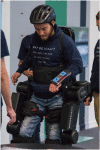Versatile Dynamic Motion Generation Framework: Demonstration With a Crutch-Less Exoskeleton on Real-Life Obstacles at the Cybathlon 2020 With a Complete Paraplegic Person
- PMID: 34631804
- PMCID: PMC8498038
- DOI: 10.3389/frobt.2021.723780
Versatile Dynamic Motion Generation Framework: Demonstration With a Crutch-Less Exoskeleton on Real-Life Obstacles at the Cybathlon 2020 With a Complete Paraplegic Person
Abstract
Lower-limb exoskeletons are a promising option to increase the mobility of persons with leg impairments in a near future. However, it is still challenging for them to ensure the necessary stability and agility to face obstacles, particularly the variety that makes the urban environment. That is why most of the lower-limb exoskeletons must be used with crutches: the stability and agility features are deferred to the patient. Clinical experience shows that the use of crutches not only leads to shoulder pain and exhaustion, but also fully occupies the hands for daily tasks. In November 2020, Wandercraft presented Atalante Evolution, the first self-stabilized and crutch-less exoskeleton, to the powered exoskeleton race of the Cybathlon 2020 Global Edition. The Cybathlon aims at promoting research and development in the field of powered assistive technology to the public, contrary to the Paralympics where only participants with unpowered assistive technology are allowed. The race is designed to represent the challenges that a person could face every day in their environment: climbing stairs, walking through rough terrain, or descending ramps. Atalante Evolution is a 12 degree-of-freedom exoskeleton capable of moving dynamically with a complete paraplegic person. The challenge of this competition is to generate and execute new dynamic motions in a short time, to achieve different tasks. In this paper, an overview of Atalante Evolution system and of our framework for dynamic trajectory generation based on the direct collocation method will be presented. Next, the flexibility and efficiency of the dynamic motion generation framework are demonstrated by our tools developed for generating the important variety of stable motions required by the competition. A smartphone application has been developed to allow the pilot to choose between different modes and to control the motion direction according to the real situation to reach a destination. The advanced mechatronic design and the active cooperation of the pilot with the device will also be highlighted. As a result, Atalante Evolution allowed the pilot to complete four out of six obstacles, without crutches. Our developments lead to stable dynamic movements of the exoskeleton, hands-free walking, more natural stand-up and turning moves, and consequently a better physical condition of the pilot after the race compared to the challengers. The versatility and good results of these developments give hope that exoskeletons will soon be able to evolve in challenging everyday-life environments, allowing patients to live a normal life in complete autonomy.
Keywords: cybathlon; direct collocation; lower-limb exoskeleton; optimal control; self-balanced; trajectory generation.
Copyright © 2021 Huynh, Burger, Dang, Pelgé, Boéris, Grizzle, Ames and Masselin.
Conflict of interest statement
Authors VH, GBu, QD, RP, GBo, and MM were employed by the company Wandercraft Company. The remaining authors declare that the research was conducted in the absence of any commercial or financial relationships that could be construed as a potential conflict of interest.
Figures











References
-
- Agrawal A., Harib O., Hereid A., Finet S., Masselin M., Praly L., et al. (2017). First Steps towards Translating Hzd Control of Bipedal Robots to Decentralized Control of Exoskeletons. IEEE Access 5, 9919–9934. 10.1109/ACCESS.2017.2690407 - DOI
-
- Carpentier J., Mansard N. (2018). “Analytical Derivatives of Rigid Body Dynamics Algorithms,” in Robotics: Science and Systems(Springer; ). 10.15607/rss.2018.xiv.038 - DOI
-
- Carpentier J., Saurel G., Buondonno G., Mirabel J., Lamiraux F., Stasse O., et al. (2019). “The Pinocchio C++ Library – a Fast and Flexible Implementation of Rigid Body Dynamics Algorithms and Their Analytical Derivatives,” in IEEE International Symposium on System Integrations (SII) (US: IEEE; ).
-
- Carpentier J., Valenza F., Mansard N. (2015-2021). Pinocchio: Fast Forward and Inverse Dynamics for Poly-Articulated Systems. Available at: https://stack-of-tasks.github.io/pinocchio.
LinkOut - more resources
Full Text Sources
Research Materials

